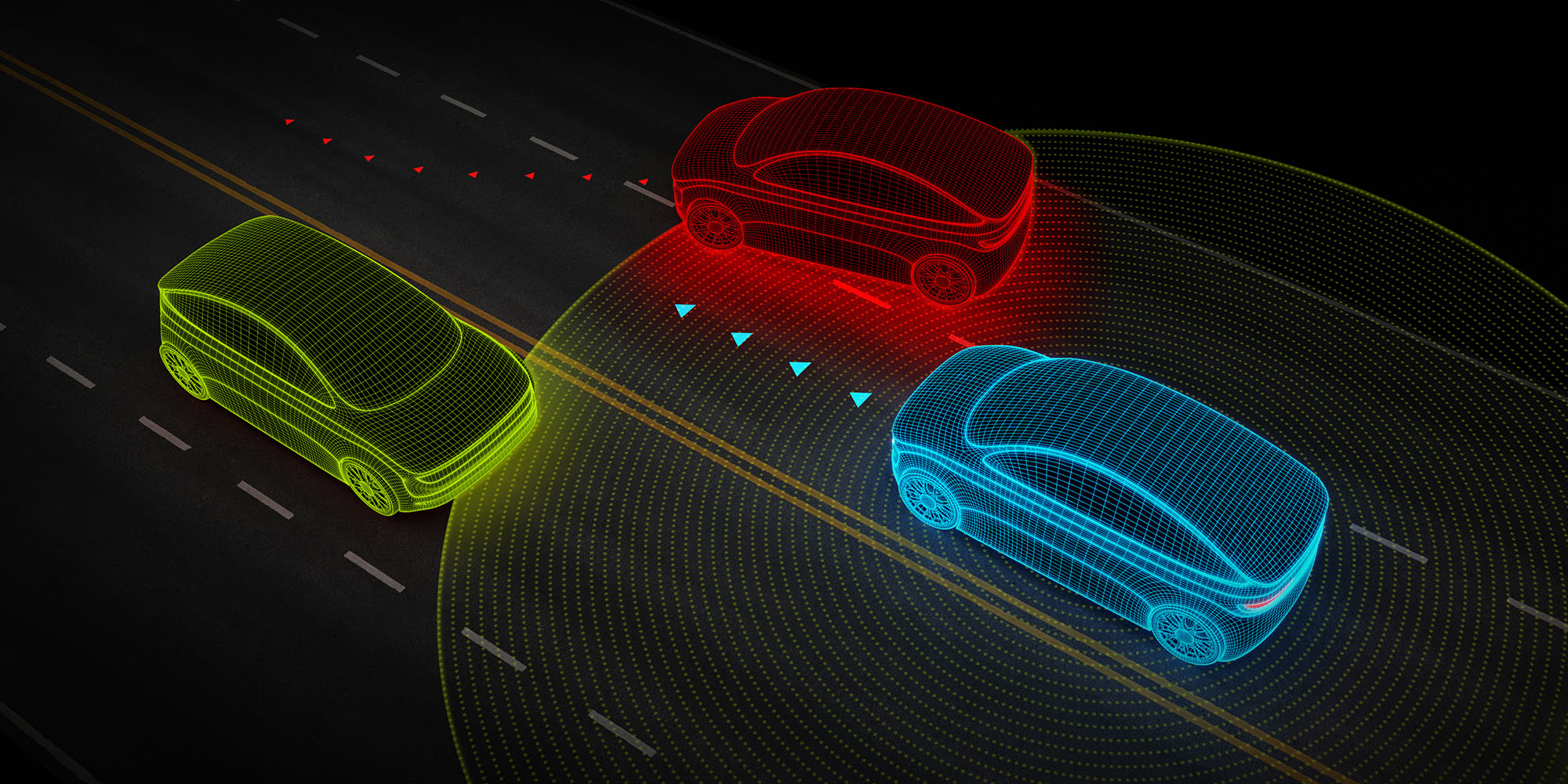
Dorian Derežić - 17/04/2024 | 8 min read
SpaceTime Advanced Driver Assistance Systems Automotive
As our vehicles become increasingly intelligent, the technologies that power them continue to evolve at a rapid pace. A prime example of this evolution is the ADAS – Advanced Driver-Assistance System.

From automatic braking and lane-keeping assist to blind spot detection, ADAS is transforming the driving experience, enhancing both safety and convenience. However, the effectiveness of these systems is intrinsically linked to their capacity for continuous learning and improvement.
The dynamic nature of driving environments necessitates that ADAS must continually evolve, learning from new situations and refining their responses. In this context, continuous learning emerges not as a luxury but as a necessity. It ensures that ADAS can accurately interpret complex driving scenarios, adjust to changing circumstances, and offer appropriate responses, even in the face of unforeseen situations.
This is where Mireo SpaceTime steps into the picture. Pioneering the charge in geospatial technology, SpaceTime's approach to ADAS optimization is rooted in the philosophy of continuous learning – in the belief that every journey, every turn, every near miss, and every safe arrival home adds to the wealth of data that can be used to refine ADAS.
The SpaceTime approach focuses on providing OEMs deep insights into vast amounts of historical data, which they can use to continually update and improve ADAS functionalities. SpaceTime harnesses the power of real-world data, gathered from a multitude of sensors embedded in vehicles. This data can then be meticulously analyzed to glean insights into driver behavior, system responses, and the outcomes of critical events.
Through this process, SpaceTime provides OEMs with a robust platform for continuous learning and improvement of ADAS. It enables them to identify opportunities to refine the system, optimize algorithms, and enhance the overall effectiveness of ADAS functionalities.
In the realm of ADAS optimization, real-world data is the foundation upon which continuous learning is built. SpaceTime leverages a network of sensors, embedded in vehicles equipped with ADAS, to gather a rich spectrum of data. This includes everything from speed and direction to braking patterns, steering input, and more.
It's through the nuanced analysis of this real-world data that SpaceTime fuels its continuous learning process, providing OEMs with a fertile ground for subsequent ADAS optimization.
A significant aspect of SpaceTime's data analysis involves understanding driver behavior. After all, driver assistance systems must work symbiotically with the driver, supplementing their skills and compensating for their shortcomings. To this end, SpaceTime can be used to examine patterns of driver behavior in diverse driving conditions and scenarios.
Understanding how drivers react to certain situations, their decision-making process, their habits and quirks, all enable OEMs to create a comprehensive model of driver behavior. This model then plays a vital role in shaping the functioning of ADAS, enabling them to complement the driver effectively and ensure safer driving experiences.
Equally critical is the examination of how ADAS responds in various situations. SpaceTime can help OEMs to delve deep into the 'brain' of ADAS, and examine the logic that fuels its decisions. Every action, from automatic braking and lane-keeping to parking assist and collision warnings, is scrutinized.
This insight helps understand how ADAS interprets sensor inputs and translates them into appropriate responses. Understanding this decision-making process allows for the identification of potential flaws in logic or areas that require fine-tuning – forming the basis for ongoing system refinement.
Lastly, data gathered and analyzed by SpaceTime can provide deep insights into critical events - situations where ADAS's actions (or lack thereof) can have significant repercussions on vehicle safety. These could range from near-miss incidents to situations where ADAS successfully mitigated a potential collision.
Analyzing these high-stake scenarios provides invaluable insights into the strengths and weaknesses of ADAS, providing clear indications of where improvements are needed. By learning from these critical events, SpaceTime facilitates a tangible enhancement in ADAS's effectiveness, boosting their ability to navigate complex, real-world scenarios safely.
In sum, the SpaceTime approach to continuous learning represents a holistic, all-encompassing process that takes into account every facet of the driving experience. By blending this wealth of information, it provides OEMs with a comprehensive framework for ongoing ADAS optimization, ensuring that these systems are continually refined to offer the highest level of safety and convenience.

After comprehensively collecting and analyzing real-world data, the next crucial step is identifying opportunities for system refinement. This involves focusing on key areas that have been shown to impact the system's performance significantly.
For instance, the analysis might reveal inconsistencies in ADAS performance under different lighting or weather conditions. Such insights become focal points for improvement, guiding the efforts towards creating a more robust and reliable ADAS.
The performance of an ADAS largely rests on the algorithms that govern its functioning - algorithms that interpret sensor data, make decisions, and ultimately control the vehicle's actions. These algorithms are initially designed based on theoretical models and assumptions, but SpaceTime can help OEMs change this approach by continuously providing them with a trove of real-world data which can be used for system optimization.
By comparing the system's performance in the real world with the initial design's expectations, Mireo SpaceTime can help OEMs to identify where the assumptions hold and where they fall short. They can then refine the algorithms based on this data that's gathered and deeply analyzed by SpaceTime – progressively enhancing ADAS' accuracy and effectiveness. This iterative process forms the core of the SpaceTime approach – ensuring that the ADAS evolves in tandem with real-world experiences.
Finally, the insights derived from data analysis and algorithm optimization need to be be fed back into the system, effectively closing the loop of continuous improvement. This stage focuses on OEMs modifying the ADAS software to incorporate the refined algorithms and recalibrating parameters, essentially enhancing the system's intelligence.
With every iteration of this process, the ADAS becomes more adept at interpreting complex sensor data, making appropriate decisions, and responding effectively in diverse scenarios. This progressive evolution ensures that the ADAS consistently improves over time, enhancing its ability to assist drivers and contribute to safer roadways.
In the cutthroat automotive industry, maintaining a competitive edge is crucial. The market is continually evolving, with technological advancements shaping customer expectations and transforming industry standards. SpaceTime's continuous learning approach helps OEMs to stay ahead of the curve by fostering innovation.
By leveraging real-world data for ongoing refinement, OEMs can consistently enhance the performance and capabilities of their ADAS. This iterative process facilitates the development of advanced features that align with emerging trends and meet customers' evolving demands, ensuring the OEMs' offerings remain relevant and competitive.
Safety is a paramount concern for customers when choosing a vehicle. By ensuring their ADAS undergo continuous refinement, OEMs can offer enhanced safety features, increasing customer satisfaction and trust.
SpaceTime's advanced data analytics provide insights into real-world scenarios, helping OEMs understand the challenges drivers face and how their ADAS can better assist. The result is an ever-improving system that not only meets but exceeds safety standards, assuring customers that their well-being is the OEM's top priority.
Real-world data offers a wealth of insights that can be harnessed for business growth. With SpaceTime's data analysis capabilities, OEMs can use these insights to uncover new opportunities for revenue generation.
For instance, data on driver behavior and system performance can inform the development of new products, features or services. Additionally, predictive analytics can help OEMs to identify trends and patterns, enabling them to anticipate customer needs and positioning them to seize emerging opportunities.

Errors and system failures in ADAS can have severe consequences. Therefore, system reliability is of utmost importance. SpaceTime can help OEMs to reduce error rates and enhance system reliability.
By regularly analyzing real-world data, SpaceTime helps to identify issues and anomalies that may lead to system errors. These insights feed back into the design process, resulting in continuous improvements that reduce error rates and enhance reliability over time.
ADAS technology is rapidly evolving, with new innovations and standards emerging regularly. OEMs need a system that can quickly adapt to these changes – and SpaceTime facilitates this adaptability.
With its data-driven approach and vast amounts of insights based on real-world data, SpaceTime prompts OEMs to make regular system updates, incorporate new technologies, meet new standards and address emerging issues. This agility ensures that the ADAS stays current with industry advancements, maintaining its performance and relevance in a fast-paced market.
Real-world conditions are unpredictable, posing a significant challenge for ADAS. SpaceTime helps OEMs to address these challenges, enhancing the robustness of ADAS.
By gathering real-world data, Mireo SpaceTime gives OEMs a holistic view of the scenarios that drivers encounter on the road, from sudden weather changes to erratic driver behavior. This exposure can be used to ensure that the ADAS can handle a wide variety of situations, improving its resilience and robustness.
As we look towards the future of ADAS, the journey is clear: a relentless pursuit of improvement and refinement. As vehicle technology evolves and consumer expectations rise, the demand for safer, more intelligent, and more reliable ADAS will continue to grow. The answer to these demands is a system that continually learns and adapts, enhancing its capabilities with every mile driven.
The ongoing mission for ADAS is not merely about adding new features but refining and optimizing existing ones to provide safer, smoother, and more intuitive assistance to drivers. The iterative design, learning, and optimization, powered by real-world data, will be at the core of this mission.